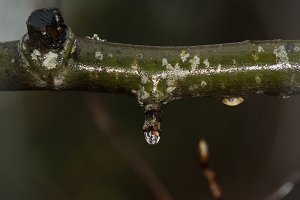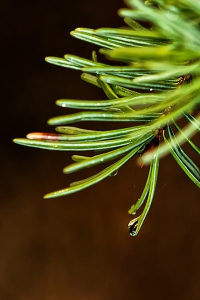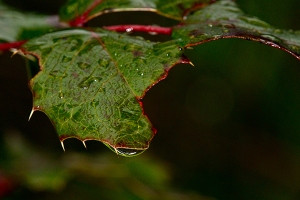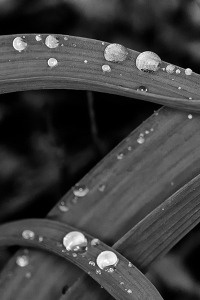Monday was another day of rain. It is spring here in the hills of Pritchard, earlier than usual, but it is spring and rainy days go with spring.
Rain doesn’t bother me much and had I thought about getting my camera and going for a drive up into the hills to see what I could find. However, as I walked through my wife’s garden on my way to the car I noticed all the drops of water hanging from branches and those leaves that made it through winter. The wet and foggy hills would have been interesting, but all those droplets were just waiting to be photographed.
How does one prepare to do photography in the rain? Put on a hat with a brim if, like me, you wear glasses. I also like rubber boots. Bring an old tea towel in your pocket to wipe the rain off your camera, and you are ready. Oh, and remember to keep the camera lens pointed down.
When the garden is dry I would usually put a couple of flashes on light stands, and add umbrellas so I can control the direction and quality of light. But when it is raining I prefer using my ring flash.
A ring flash fits tightly around the front of my 200mm macro lens and is perfect for building reflections on the droplets of water that were clinging to branches and sparse foliage that I wandered around photographing.
I expect many photographers prefer waiting out the rain and the unappetizing low, flat light on rainy days. I can understand that. Rain is such a hassle, and getting wet is uncomfortable. Nevertheless, that flat light, slight breeze, and wet conditions forced me to approach my subjects differently and I like that challenge.
In the low light of a rainy day we don’t think about light in the same way as we do on a sunny day. Everything is usually about colour, and how to deal with the contrast, especially on a bright spring day.
When the light is low one needs to see tonality and shape, and raindrops are a challenging element to add. In this instance there was also a slight, intermittent breeze.
I chose a setting that without a flash everything would be underexposed. That means I would only see my subjects when they were properly exposed and a flash is the best way to do that. Using my camera’s manual mode I selected 1/250th of a second and I kept my aperture at f/11 so I would have as much depth of field as possible when and if a branch shook back and forth in the breeze. I also switched my flash to a manual mode. The flash power would always be the same putting out the same amount of light. I then could control exactly how much light I wanted for each location.
I could have increased my ISO and shutterspeed if I had decided to only use natural light, but then everything would have been flat and it would have been hard to get a sparkle in the raindrops.
I know it can be disappointing to see those gray clouds on your day off when you had made plans to be out shooting. However, keep a positive attitude, remember you don’t have to go far, and with a bit of creative thinking and preparation you’ll be out having fun making photos, even in wet weather.
I always look forward to everyone’s comments. Thanks, John








These are just beautiful. Your technique is very interesting to me. One question: do you bounce the flash or is it direct?
LikeLike
Hi oneowner, I am really glad you liked my pictures. And thanks for the comment regarding direction of light.
I wrote, “…when it is raining I prefer using my ring flash. A ring flash fits tightly around the front of my 200mm macro lens and is perfect for building reflections on the droplets of water…”
So the light is very direct and comes from a location very close to the lens. The flash also has a diffuser. LIght that close to the lens is such a direct source that it effects the subject differently than a flash mounted on the camera. I like it on wet days because it give a “sparkle” to water.
LikeLike
a ring flash is on my wishlist, too. Lovely shots, I especially like the penultimate shot with the red bits. 🙂
LikeLike
Thanks fragg, I had a hard time with that shot because of the breeze. I will admit to adding sharpness to the droplet.
I am sure you’ll really like using a ringflash.
LikeLiked by 1 person
Eventually will get one! So mNy things on my wish list 🙂
LikeLike
great picture. i tried to take a picture after the rain too. But, none of it beautiful enough for me. DO you have any tips?
LikeLike
Hi Blank…I am pleased you enjoyed my pictures. You asked for tips..I’ll tell you how I do my photos.
My camera is usually set to manual exposure mode.
That allows me, not the camera, to choose the overall ambient exposure, and add flash to those areas that are underexposed by shadows. I meter the existing light, set the exposure, and make tests.
The exposure is made exactly the same way I would have made it as if photographing a person in an outdoor studio; slightly underexpose the ambient light and “fill” the subject with the light from a flash.
Sometimes I use the flash on manual mode as I did in this article. There are also times when I choose to use the flash in TTL mode. (that is when the flash is fully auto)
If you have some time read my articles:
TTL Flash Photography in my Wife’s Garden. (March 2013)
Using a ring flash. (June 2011)
LikeLike
Hey, great article. Almost makes me wish it would rain! Your photos are Lovely John. Would a ring flash be good for photographing bees?
LikeLike
I think it might. stop by when ya have the chance.
LikeLike